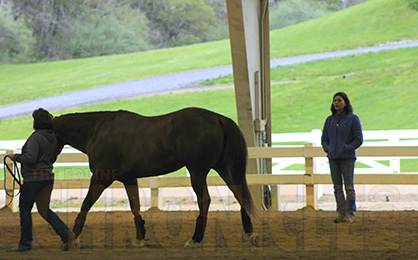A Horse at Home is Still at Risk For Ulcers
Risks for Your Horse at Home
Horses that stay home or rarely compete are not immune to stomach ulcers.2Cheramie cites these situations as examples of what can cause them including:
- Light training3
- Short-term travel3
- Trailering3
- Change in routine4
- Change in feed schedule5
- Limited turnout or grazing5
- Lay-up due to sickness or injury5
- Radio in the barn6
- Social regrouping2,7
Cheramie notes that removing horses from their social group may be one of the major contributing factors to an increased incidence of stomach ulcers in those left at home.2
“Off-site training and showing can cause a disruption in social groupings and can be anxiety-provoking for some,” Cheramie says. “Horses form strong emotional bonds with their stable-mates so when they are separated, it can be very upsetting for both horses.”
Social grouping disruptions are also more common when spring arrives, as it often heralds a busy time for everyone, especially those with broodmares. Foaling season means additional stress not only on mares and foals, but also for other horses as well due to increased activity in the barn at irregular hours.
Know the Signs of Ulcer Presence
Watch out for clinical signs of ulcers, which include:
- Decreased appetite4
- Weight loss or poor body condition4
- Change in attitude for the worse4
- Recurrent colic4
- Dull hair coat4
- Less-than-optimal (poor) performance, resistance to work, difficulty training4
However, Cheramie makes a point to say that some horses may not exhibit overt signs. If there is the slightest suspicion something is not quite right, it is better to call a veterinarian who can make an accurate diagnosis, which typically will involve performing an gastroscopy to provide a view of the stomach lining.
“‘Scoping’ is a procedure in which a long, flexible tube with a camera at the end is introduced through the nostril and passed to the throat and down the esophagus, into the stomach, which is then examined for the presence of ulcers,” Cheramie explains.
Ulcer Prevention: ULCERGARD® (Omeprazole) Provides a Strong Solution
Available without a prescription, a single daily dose of ULCERGARD is the only proven and FDA-approved product with a patented formulation that protects the omeprazole from stomach acid to ensure it gets to the intestines to effectively prevent ulcers.3
But when ulcers do form, a 28-day regimen of GASTROGARD® (omeprazole) is the only FDA-approved product for treatment so that horses can continue with their training routine and protect that winning edge.9
IMPORTANT SAFETY INFORMATION:
ULCERGARD can be used in horses that weigh at least 600 pounds. Safety in pregnant mares has not been determined.
Caution: Safety of GASTROGARD in pregnant or lactating mares has not been determined.
About Boehringer Ingelheim Animal Health
On January 1st, 2017, Merial became part of the Boehringer Ingelheim group. As the second largest animal health business in the world, Boehringer Ingelheim is committed to making the industry even better at improving animal health. With more than 10,000 employees worldwide, Boehringer Ingelheim Animal Health has products available in more than 150 markets and a global presence in 99 countries. For more information about Boehringer Ingelheim Animal Health, click here.
About Boehringer Ingelheim
Boehringer Ingelheim is one of the world’s 20 leading pharmaceutical companies. Headquartered in Ingelheim, Germany, Boehringer Ingelheim operates presently with a total of some 50,000 employees worldwide. The focus of the family-owned company, founded in 1885, is on researching, developing, manufacturing and marketing new medications of high therapeutic value for human and veterinary medicine. In 2015, Boehringer Ingelheim achieved net sales of about 14.8 billion euros. R&D expenditure corresponds to 20.3 per cent of net sales. For more information, please visit www.boehringer-ingelheim.com.
Merial is now part of Boehringer Ingelheim.
®GASTROGARD and ULCERGARD are registered trademarks of Merial. ©2017 Merial, Inc., Duluth, GA. All rights reserved. EQUIUGD1704 (04/17)
2McClure SR, Carithers DS, Gross SJ, Murray MJ. Gastric ulcer development in horses in a simulated show or training environment. J Am Vet Med Assoc. 2005;227(5):775-777.
3ULCERGARD Product Label
4Equine Gastric Ulcer Council. Recommendations for the diagnosis and treatment of Equine Gastric Ulcer Syndrome (EGUS).Equine Vet Educ. 1999;11:262-272.
5Murray MJ. Disorders of the stomach. In: Smith BP, ed. Lg Anim Int Med. St. Louis; CV Mosby, 1990:710-717.
6Lester, GD, Robertson I, Secombe C. Rural Industries Research and Development Corporation (Australia) 2008. Risk factors for gastric ulceration in thoroughbred racehorses. Rural Research and Development Corporation, Barton, A.C.T.
7Merck Veterinary Manual Online Edition. Available at:
http://www.merckvetmanual.com/mvm/digestive_system/gastrointestinal_ulcers_in_large_animals/gastric_ulcers_in_horses.html Accessed March 13, 2017.
8Murray MJ. Overview of Equine Gastroduodenal Ulceration. AAEP Proceedings. 1997;43:382-387.
9GASTROGARD Product Label











